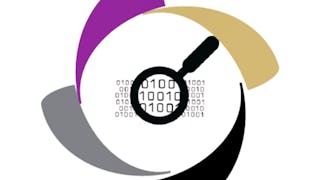Over 10,600 confirmed breaches were reported globally in 2024, exposing millions of records, including sensitive healthcare and financial data. Organizations need cybersecurity professionals who can protect them against this costly risk. This Encryption and Cryptography Essentials course gives aspiring cybersecurity professionals job-ready skills in encryption, hashing, and digital signatures—key competencies employers are looking for.


Encryption and Cryptography Essentials
本课程是 Cybersecurity Fundamentals 专项课程 的一部分


位教师:Dr. Manish Kumar
2,521 人已注册
包含在 中
您将学到什么
Job-ready encryption and cryptography skills for cybersecurity employers need in just 4 weeks.
How to classify cryptographic algorithms and key exchange protocols and identify their applications in securing data
How to identify and apply encryption techniques to secure communication and ensure data privacy.
How to use hashing algorithms and digital signatures in blockchain to secure transactions, validate identities, and ensure data integrity.
您将获得的技能
要了解的详细信息

添加到您的领英档案
10 项作业
了解顶级公司的员工如何掌握热门技能

积累特定领域的专业知识
- 向行业专家学习新概念
- 获得对主题或工具的基础理解
- 通过实践项目培养工作相关技能
- 获得可共享的职业证书

该课程共有4个模块
In this module, you will learn the foundational concepts of cryptography and its essential role in data security. You will classify cryptographic algorithms by their functions. and conduct cryptanalysis using OpenSSL. The module covers asymmetric and symmetric cryptography principles, including RSA and Elliptic Curve Cryptography (ECC), with practical exercises in RSA and AES encryption. Additionally, you will explore key exchange protocols like Diffie-Hellman and The Elliptic Curve Diffie-Hellman (ECDH), culminating in hands-on experience with Diffie-Hellman key exchanges for secure data transmission
涵盖的内容
7个视频2篇阅读材料3个作业3个应用程序项目8个插件
In this module, you will identify basic encryption techniques and their applications while recognizing the distinctions among full-disk, partition, file, and volume encryption. You will describe the role of transport encryption and define the principles of Public Key Infrastructure (PKI), including the roles of Certificate Authorities (CAs) and various trust models. Additionally, you will explore the features of the Trusted Platform Module (TPM), Hardware Security Module (HSM), and Secure Enclave for data protection, as well as obfuscation techniques such as steganography, tokenization, and data masking
涵盖的内容
7个视频1篇阅读材料4个作业2个应用程序项目5个插件
In this module, you will identify the fundamentals of hashing algorithms, including MD5 and SHA, and apply hashing techniques using OpenSSL to generate secure hashes. You will explain the purpose and importance of digital signatures for data integrity, utilizing OpenSSL to create and verify these signatures. Additionally, you will describe the basics of blockchain technology and its various applications, recognize the role and structure of digital certificates in cybersecurity, and explain the Online Certificate Status Protocol (OCSP) for verifying certificate validity. Finally, you will differentiate between self-signed and third-party certificates in certificate management.
涵盖的内容
7个视频1篇阅读材料3个作业3个应用程序项目7个插件
In this module, you will apply the knowledge gained in the course in a final project. You will get to apply the different techniques you have learnt throughout the course in a simulated scenario. The module also wraps up the course learning and highlights key takeaways and next steps.
涵盖的内容
1个视频2篇阅读材料2个应用程序项目2个插件
获得职业证书
将此证书添加到您的 LinkedIn 个人资料、简历或履历中。在社交媒体和绩效考核中分享。
提供方
从 Security 浏览更多内容
 状态:免费试用
状态:免费试用 状态:免费试用
状态:免费试用University of Colorado System
 状态:免费试用
状态:免费试用
人们为什么选择 Coursera 来帮助自己实现职业发展




常见问题
In this course, you'll learn the fundamentals of encryption, including symmetric and asymmetric encryption algorithms, hashing techniques, digital signatures, and the role of Public Key Infrastructure (PKI). You’ll also explore blockchain technology, cryptographic attacks, and methods for securing data in various real-world applications.
As this is an intermediate-level course, basic knowledge of cybersecurity, including cybersecurity architecture, is essential.
You’ll gain hands-on experience with tools like OpenSSL to generate hashes and digital signatures, as well as apply encryption algorithms in practical scenarios. By the end of the course, you’ll be able to implement cryptographic solutions to secure data, protect communication, and evaluate cryptographic methods.
更多问题
提供助学金,




